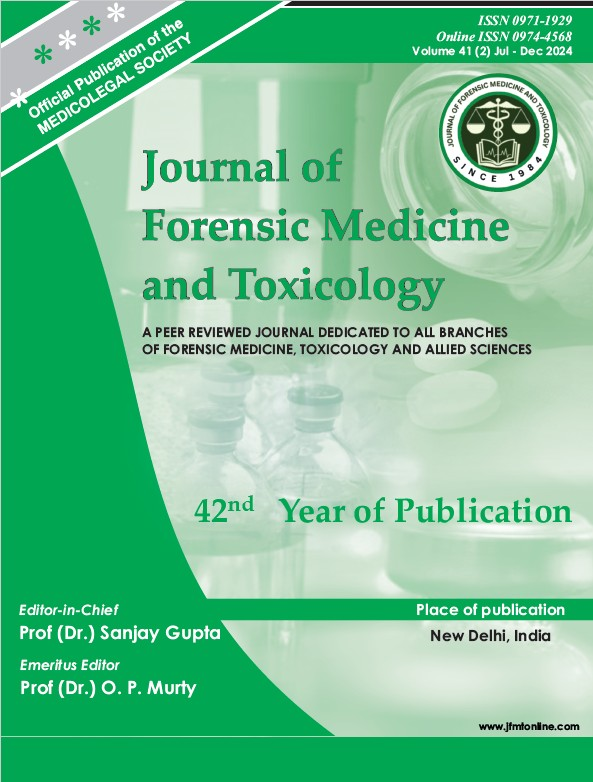RATE OF DECOMPOSITION OF RABBIT CARCASSES IN DIFFERENT SEASONS OF ANDAMAN AND NICOBAR ISLANDS, INDIA
DOI:
https://doi.org/10.48165/jfmt.2024.41.2.29Keywords:
forensic taphonomy, orensic entomology, time since death, post mortem interval, forensically important insects etcAbstract
Time since death is an important part of investigation. The major factors for estimation of time since death are environmental condition, and role of insects and their activities. In forensic taphonomy, the basic requirement to fulfill the requirement of post mortem estimation, are the reference data of decomposition in different climatic conditions with some other factors in a particular area. In India, very few studies have been done region wise. But, in Andaman and Nicobar Islands, India, this is the first study considering forensic entomology and taphonomy. In the four experiments of this study done on the rabbit carcasses (Oryctolagus cuniculus), the basic idea of on rate of decomposition and forensically important insects has been collected. In this study, the duration of rate of decomposition in rainy season of A&N Islands is noticed faster than summer season. The role of temperature and ants are also found affecting rate of decomposition.
Downloads
References
Lutz L, Zehner R, Verhoff MA, Bratzke H, Amendt J. It is all about the insects: a retrospective on 20 years of forensic entomology highlights the importance of insects in legal investigations. Int J Legal Med. 2021 Nov;135(6):2637-2651.
Devinder Singh and Meenakshi Bharti. Decay Pattern and Insect Succession on Rabbit Carcasses During Different Seasons. JPAS Vol.2 (number I) 2000: 183- 185.
Payne JA. A summer carrion study of the baby pig Sus scrofa Linnaeus. Ecology (1965)46, 592–602.
T. Bonacci et al. Successional patterns of the insect fauna on a pig carcass in southern Italy and the role of Crematogaster scutellaris (Hymenoptera, Formicidae) as a carrion invader. Entomological Science (2011) 14, 125–132.
Campobasso CP, Di Vella G, Introna F. Factors affecting decomposition and Diptera colonization. Forensic Sci. Int 2001; 120(1):18-27.
Voss SC, Spafford H, Dadour IR. Annual and seasonal patterns of insect succession on decomposition remains at two locations in Western Australia. Forensic
Science International 2009; 193(1):26-36.
Archer MS. Rainfall and temperature effects on the decomposition rate of exposed neonatal remains. Science& Justice 2004; 44(1):35-41.
Mohammed GM Zeariya et al. Forensic - insect succession and decomposition patterns of dog and rabbit carcasses in different Habitats. Journal of Entomology and Zoology Studies 2015; 3(5): 473-482.
Jens Amendt et al. Forensic entomology Naturwissenschaften (2004) 91:51–65. DOI 10.1007/ s00114-003-0493-5.
Shedge R, et al.Postmortem Changes. 2023 Jul 24. In: StatPearls [Internet]. Treasure Island (FL): StatPearls Publishing; 2023 Jan–. PMID: 30969563.
Meenakshi Bharti & Devinder Singh. Insect Faunal Succession on Decaying Rabbit Carcasses in Punjab, India.J Forensic Sci, September 2003, Vol. 48, No. 5.
Joseph I. et al. The use of insects in forensic investigations: An overview on the scope of forensic entomology. J Forensic Dent Sci. 2011 Jul;3(2):89-91.
Ubelaker DH, Zarenko KM. Adipocere: what is known after over two centuries of research. Forensic Sci Int. 2011 May 20;208(1-3):167-72.
Rodriguez, William C. “Decomposition of Buried and Submerged Bodies.” (1997).
Houlton TMR, Wilkinson C. Facial preservation following extreme mummification: Shrunken heads. Forensic Sci Int. 2018 May;286:31-41.
Carlo Pietro Campobasso et al. Facots affecting decomposition and diptera colonisation. Forensic Science International 120 (2001) 18-27.
Hill MA, Pokines JT. Comparative analysis of fetal pig decomposition processes in burials of variable depths and wrapping. J Forensic Sci. 2022 Nov;67(6):2192-2202.
Abrar Essarras et. Al. A Preliminary Investigation of Insect Succession Patterns on Decomposing Carrion on Rottnest Island (WA). Journal of clinical and health sciences.Vol 6(1) (Special Issue) (2021) 4-16.
Ives, Anthony R. (March 1991).”Aggregation and coexistence in a carrion fly community”. Ecological Monographs. 61 (1): 75–94.
Carter DO, et al. Cadaver decomposition in terrestrial ecosystems. Naturwissenschaften. 2007 Jan;94(1):12- 24.
Losch S, et al. Mummies and skeletons from the Coptic monastery complex Deir el-Bachit in Thebes-West, Egypt. Anthropol Anz. 2013;70(1):27-41.




